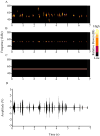Perirhinal cortex supports acquired fear of auditory objects
- PMID: 19185613
- PMCID: PMC2700730
- DOI: 10.1016/j.nlm.2009.01.002
Perirhinal cortex supports acquired fear of auditory objects
Abstract
Damage to rat perirhinal cortex (PR) profoundly impairs fear conditioning to 22kHz ultrasonic vocalizations (USVs), but has no effect on fear conditioning to continuous tones. The most obvious difference between these two sounds is that continuous tones have no internal temporal structure, whereas USVs consist of strings of discrete calls separated by temporal discontinuities. PR was hypothesized to support the fusion or integration of discontinuous auditory segments into unitary representations or "auditory objects". This transform was suggested to be necessary for normal fear conditioning to occur. These ideas naturally assume that the effect of PR damage on auditory fear conditioning is not peculiar to 22kHz USVs. The present study directly tested these ideas by using a different set of continuous and discontinuous auditory cues. Control and PR-damaged rats were fear conditioned to a 53kHz USV, a 53kHz continuous tone, or a 53kHz discontinuous tone. The continuous and discontinuous tones matched the 53kHz USV in terms of duration, loudness, and principle frequency. The on/off pattern of the discontinuous tone matched the pattern of the individual calls of the 53kHz USV. The on/off pattern of the 50kHz USV was very different from the patterns in the 22kHz USVs that have been comparably examined. Rats with PR damage were profoundly impaired in fear conditioning to both discontinuous cues, but they were unimpaired in conditioning to the continuous cue. The implications of this temporal discontinuity effect are explored in terms of contemporary ideas about PR function.
Figures





Similar articles
-
Fear conditioning to discontinuous auditory cues requires perirhinal cortical function.Behav Neurosci. 2008 Oct;122(5):1178-85. doi: 10.1037/a0012902. Behav Neurosci. 2008. PMID: 18823174
-
Single-unit responses to 22 kHz ultrasonic vocalizations in rat perirhinal cortex.Behav Brain Res. 2007 Sep 4;182(2):327-36. doi: 10.1016/j.bbr.2007.03.009. Epub 2007 Mar 16. Behav Brain Res. 2007. PMID: 17445914 Free PMC article.
-
Auditory trace fear conditioning requires perirhinal cortex.Neurobiol Learn Mem. 2008 Oct;90(3):537-43. doi: 10.1016/j.nlm.2008.06.006. Epub 2008 Aug 21. Neurobiol Learn Mem. 2008. PMID: 18678265 Free PMC article.
-
Asymmetrical stimulus generalization following differential fear conditioning.Neurobiol Learn Mem. 2008 Jul;90(1):200-16. doi: 10.1016/j.nlm.2008.02.009. Epub 2008 Apr 22. Neurobiol Learn Mem. 2008. PMID: 18434217 Free PMC article.
-
Perirhinal cortex supports delay fear conditioning to rat ultrasonic social signals.J Neurosci. 2004 Apr 7;24(14):3610-7. doi: 10.1523/JNEUROSCI.4839-03.2004. J Neurosci. 2004. PMID: 15071109 Free PMC article.
Cited by
-
Positive and negative ultrasonic social signals elicit opposing firing patterns in rat amygdala.Behav Brain Res. 2012 Jan 1;226(1):77-86. doi: 10.1016/j.bbr.2011.08.040. Epub 2011 Sep 3. Behav Brain Res. 2012. PMID: 21911010 Free PMC article.
-
Zinc transporter 3 is involved in learned fear and extinction, but not in innate fear.Learn Mem. 2010 Oct 29;17(11):582-90. doi: 10.1101/lm.1962010. Print 2010 Nov. Learn Mem. 2010. PMID: 21036893 Free PMC article.
-
Associative properties of the perirhinal network.Cereb Cortex. 2012 Jun;22(6):1318-32. doi: 10.1093/cercor/bhr212. Epub 2011 Aug 12. Cereb Cortex. 2012. PMID: 21841156 Free PMC article.
-
Dual functions of perirhinal cortex in fear conditioning.Hippocampus. 2012 Oct;22(10):2068-79. doi: 10.1002/hipo.22058. Epub 2012 Aug 18. Hippocampus. 2012. PMID: 22903623 Free PMC article. Review.
-
Environmental variables that ameliorate extinction learning deficits in the 129S1/SvlmJ mouse strain.Genes Brain Behav. 2019 Sep;18(7):e12575. doi: 10.1111/gbb.12575. Epub 2019 May 7. Genes Brain Behav. 2019. PMID: 30973205 Free PMC article.
References
Publication types
MeSH terms
Substances
Grants and funding
LinkOut - more resources
Full Text Sources
Research Materials

